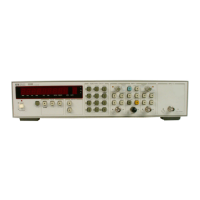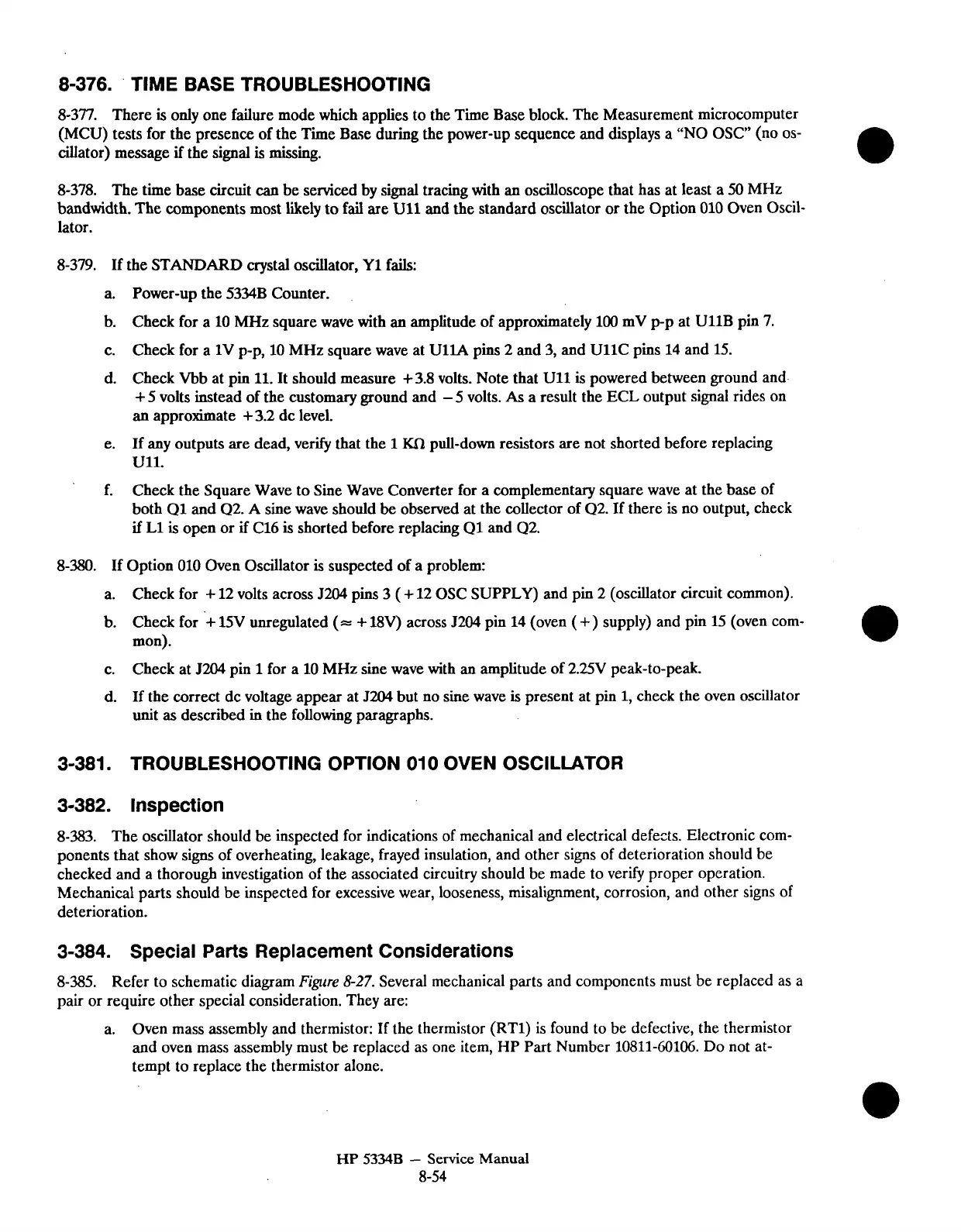8-376.
'
TIME BASE TROUBLESHOOTING
8-377. There is only one failure mode which applies to the Time Base block. The Measurement microcomputer
(MCU) tests for the presence of the Time Base during the power-up sequence and displays a "NO OSC" (no os-
cillator) message
if
the signal
is
missing.
8-378. The time base circuit
can
be serviced by signal tracing with an oscilloscope that has at least a 50
MHz
bandwidth. The components most likely to fail are U11 and the standard oscillator or the Option 010 Oven Oscil-
lator.
8-379. If the STANDARD crystal oscillator,
Y1 fails:
a. Power-up the
5334B Counter.
b. Check for a 10
MHz
square wave with
an
amplitude of approximately 100 mV p-p at UllB pin 7.
c. Check for a
1V p-p, 10
MHz
square wave at UllA pins 2 and
3,
and UllC pins 14 and 15.
d. Check
Vbb at pin
11.
It should measure
+
3.8 volts. Note that U11
is
powered between ground and
+
5 volts instead of the customary ground and
-
5 volts.
As
a result the ECL output signal rides on
an
approximate
+
3.2 dc level.
e.
If any outputs are dead, verify that the
1
ICn
pull-down resistors are not shorted before replacing
U11.
f. Check the Square Wave to Sine Wave Converter for a complementary square wave at the base of
both
Q1 and Q2.
A
sine wave should be observed at the collector of Q2. If there is no output, check
if
L1
is
open or
if
C16
is
shorted before replacing Q1 and Q2.
8-380. If Option 010 Oven Oscillator
is
suspected of a problem:
a.
Check for
+
12 volts across 5204 pins 3
(
+
12 OSC SUPPLY) and pin 2 (oscillator circuit common).
b.
Check for
'+
15V unregulated
(=
+
18V) across
5204
pin 14 (oven
(+)
supply) and pin 15 (oven com-
mon).
c.
Check at
5204
pin
1
for a 10
MHz
sine wave with an amplitude of 2.25V peak-to-peak.
d.
If the correct dc voltage appear at
J204
but no sine wave
is
present at pin 1, check the oven oscillator
unit as described in the following paragraphs.
3-381. TROUBLESHOOTING OPTION 010 OVEN OSCILLATOR
3-382. Inspection
8-383. The oscillator should be inspected for indications of mechanical and electrical defects. Electronic com-
ponents that show signs of overheating, leakage, frayed insulation, and other signs of deterioration should be
checked and a thorough investigation of the associated circuitry should be made to verify proper operation.
Mechanical parts should be inspected for excessive wear, looseness, misalignment, corrosion, and other signs of
deterioration.
3-384. Special Parts Replacement Considerations
8-385. Refer to schematic diagram Figure
8-27.
Several mechanical parts and components must be replaced as a
pair or require other special consideration. They are:
a.
Oven mass assembly and thermistor: If the thermistor
(RT1) is found to be defective, the thermistor
and oven mass assembly must be replaced as one item, HP Part Number
10811-60106. Do not at-
tempt to replace the
thexmistor alone.
HP
5334B
-
Service
Manual
8-54

